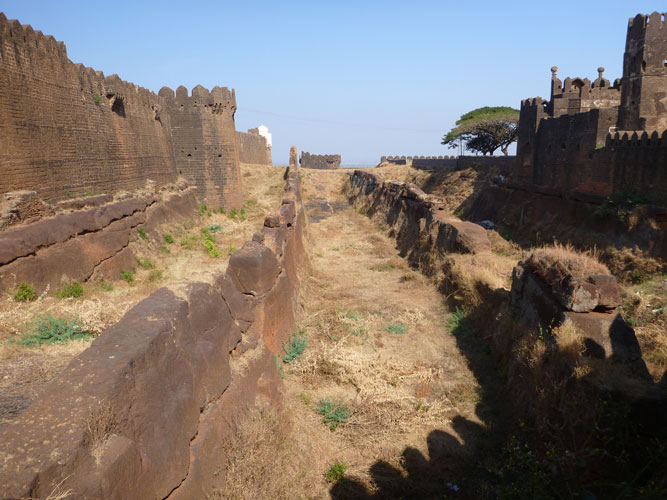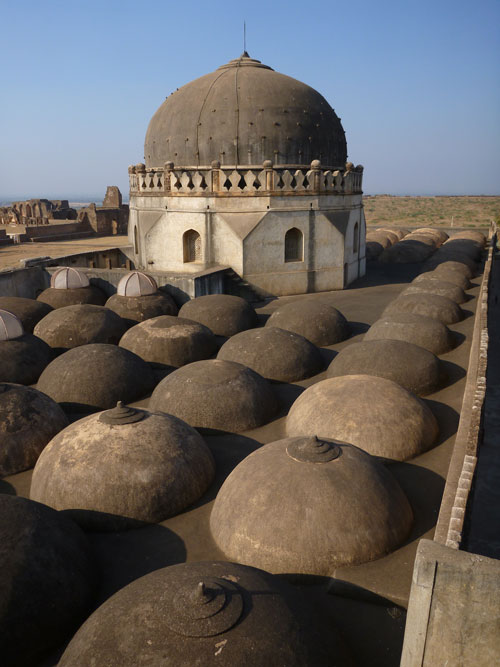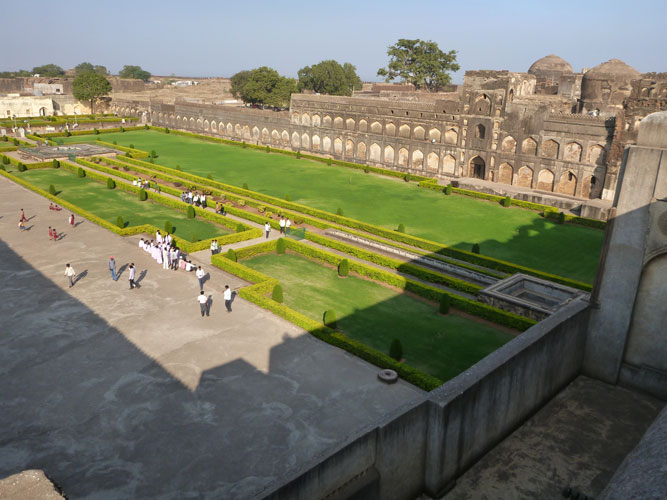INDIAN RAMBLE 2011-12
Part 3 Vicinity of Hyderabad
Bidar
While in Hyderabad, I made a side trip west to the old town
of Bidar in Karnataka state so see the 15th-century Bidar Fort, full
of grand palaces surrounded by elaborate defenses. An outer wall encloses the
old part of town, while two inner walls, separated by moats cut into solid rock,
protect the palaces and grand mosque at the center. Although in ruins, there’s
enough left to get a feel for the medieval setting when the Bahmani kingdom
ruled over much of southern India. The Rangin Mahal (Painted Palace) best
recalls the grandeur of the past with remnants of colorful tile,
mother-of-pearl inlays, and ornate woodwork. A guide led me into the eerie
depths of the Tarkash Mahal (Turkish Palace) and scooped up a black
substance, saying it was old gunpowder.

To invade Bidar Fort, one would have to scale three walls (two shown here) and
cross these three moats cut into bedrock.

Inside Rangin Mahal at Bidar Fort

Rooftop of Solah Kumba (Sixteen-Pillared Mosque) viewed from the top of Tarkash Mahal

The public courtyard of Bidar Fort, from the top of Tarkash Mahal
Warangal and Palampet
Another bus ride took me to Warangal in the far north of Andhra Pradesh to
see yet another fort and some temples. The Hindu Kakatiya kingdom reigned here
from the late 12th to early 14th centuries, supporting Telugu arts and temple
construction. Although the town’s fort lacked the grand scale and defenses of
Golconda and Bidar, it had an intriguing ruin of a large Shiva temple with
intricate carvings in a black stone. Time and vandals had badly worn most of the
stonework, but somehow the four main gates stand almost perfectly preserved;
present-day Warangal has adopted them as the town’s symbol. A nearby
single-chambered stone palace building features a soaring ceiling and a
collection of Hindu sculptures. In another part of town, the 1000-Pillared
Temple dates from 1163 and has three equal-sized shrines, originally to the gods
Shiva, Vishnu, and Surya with fine stonework, though only the Shiva shrine still
had its deity. I was disappointed to find most of the 1000 pillars missing!
Apparently they had been taken down for a reconstruction project. I had better
luck with the Ramappa Temple, dating from 1234 and way out in the countryside at
Palampet, 65
kilometers northeast of Warangal. Here hundreds of bare-breasted dancing beauties,
frozen in stone, grace the pillars, door jambs, beams, and roof brackets of the
well preserved temple. A large glossy stone Nandi, Shiva’s bull, faces the
innermost sanctum where Shiva as a lingam is still worshipped. I spent hours
admiring the sculptural work, which also includes gods, lions, and long rows of
elephants.

Finely carved remnants of the Shiva temple in Warangal Fort. One of the four
gates is in the distance.

Schoolgirls caress the Nandi in front of Ramappa Temple.

A shiny brass-covered Shiva lingam resides in the heart of
Ramappa Temple, entered through this doorway covered in dancing figures.

Ecstatic dancers on a column in Ramappa Temple

Finger movements are important in classical Indian dance.
This lady
is helping to support the roof of Ramappa Temple.

Village life near Ramappa Temple still moves as the pace of an ox cart.
On to Bhopal
Back to the Beginning of Indian Ramble









